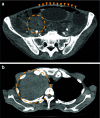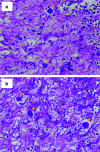Lethal multiple colon necrosis and perforation due to fulminant amoebic colitis: a surgical case report and literature review
- PMID: 33469722
- PMCID: PMC7815445
- DOI: 10.1186/s40792-020-01095-2
Lethal multiple colon necrosis and perforation due to fulminant amoebic colitis: a surgical case report and literature review
Abstract
Background: Amoebiasis caused by the protozoan species Entamoeba histolytica rarely develops into fulminant amoebic colitis (FAC), but when it does, it shows an aggressive clinical course including colonic perforation, necrotizing colitis, and high mortality. Surgical treatment for FAC patients should be carried out urgently. However, even after surgery, the mortality rate can be 40-50%. Although FAC is one of the most unfavorable surgical diseases with a poor prognosis, there are a few reports on the perioperative diagnosis and management of FAC based on autopsy findings. We herein report the surgical case of a 64-year-old man who developed multiple colon necrosis and perforation due to FAC. A detailed autopsy revealed FAC as the cause of death. Additionally, we reviewed the existing literature on FAC patients who underwent surgery and followed their perioperative diagnosis and management.
Case presentation: A 64-year-old man presented with anorexia, diarrhea, and altered consciousness on arrival to our hospital. Computed tomography revealed a large mass in the upper right lobe of his lung, and the patient was admitted for close investigation. Bloody diarrhea, lower abdominal pain, and hypotension were observed soon after admission. Urgent abdominal contrast-enhanced computed tomography scan revealed extensive intestinal ischemia, intestinal pneumatosis, and free intra-abdominal gas. The preoperative diagnosis was bowel necrosis and perforation with intussusception of the small intestinal tumor. Emergency subtotal colectomy and enterectomy were performed soon after the contrast-enhanced computed tomography. He was taken to an intensive care unit after surgery. However, he could not recover from sepsis and died with disseminated intravascular coagulation and multiple organ failure on the 10th-day post-surgery. A histopathological examination of the resected colon showed transmural necrosis and massive amoebae invasion. He was diagnosed with FAC. An autopsy revealed that he had developed pulmonary large cell carcinoma with small intestinal metastasis. The death was caused by intestinal ischemia, necrosis and the perforation of the residual bowel caused by amoebae invasion.
Conclusions: Since FAC is a lethal disease with a high mortality rate and antibiotic therapies except metronidazole are ineffective, preoperative serological testing and perioperative metronidazole therapy in FAC patients can dramatically improve their survival rates.
Keywords: Bowel perforation; Colectomy; Fulminant amoebic colitis; Intestinal necrosis; Metronidazole; Serological testing.
Conflict of interest statement
The authors declare that they have no competing interests.
Figures





Similar articles
-
Fulminant amoebic colitis with perforation successfully treated by staged surgery: a case report.J Gastroenterol. 2003;38(1):92-6. doi: 10.1007/s005350300013. J Gastroenterol. 2003. PMID: 12560929
-
Fulminant necrotizing amoebic colitis presenting as acute appendicitis: a case report and comprehensive literature review.J Infect Dev Ctries. 2022 Apr 30;16(4):717-725. doi: 10.3855/jidc.15419. J Infect Dev Ctries. 2022. PMID: 35544636 Review.
-
Multiple colonic and ileal perforations due to unsuspected intestinal amoebiasis-Case report and review.Pathol Res Pract. 2020 Jan;216(1):152608. doi: 10.1016/j.prp.2019.152608. Epub 2019 Aug 19. Pathol Res Pract. 2020. PMID: 31564573 Review.
-
Successful treatment with metronidazole and paromomycin for fulminant amoebic colitis during cytotoxic chemotherapy in a patient with small-cell lung cancer.IDCases. 2021 Nov 16;26:e01337. doi: 10.1016/j.idcr.2021.e01337. eCollection 2021. IDCases. 2021. PMID: 34840954 Free PMC article.
-
Acute fulminant necrotizing amoebic colitis: a rare and fatal complication of amoebiasis: a case report.Cases J. 2009 Sep 11;2:6557. doi: 10.4076/1757-1626-2-6557. Cases J. 2009. PMID: 19918532 Free PMC article.
Cited by
-
Identification of asymptomatic Entamoeba histolytica infection by a serological screening test: A cross-sectional study of an HIV-negative men who have sex with men cohort in Japan.PLoS Negl Trop Dis. 2022 Apr 25;16(4):e0009793. doi: 10.1371/journal.pntd.0009793. eCollection 2022 Apr. PLoS Negl Trop Dis. 2022. PMID: 35468146 Free PMC article.
-
Non-clostridium difficile induced pseudomembranous colitis.World J Clin Cases. 2023 Feb 16;11(5):979-988. doi: 10.12998/wjcc.v11.i5.979. World J Clin Cases. 2023. PMID: 36874439 Free PMC article. Review.
-
Double Trouble: The Perilous Intersection of Amoebic Colitis and Candida Infection Leading to Colonic Perforation.Cureus. 2024 Oct 12;16(10):e71292. doi: 10.7759/cureus.71292. eCollection 2024 Oct. Cureus. 2024. PMID: 39529792 Free PMC article.
References
LinkOut - more resources
Full Text Sources
Other Literature Sources

